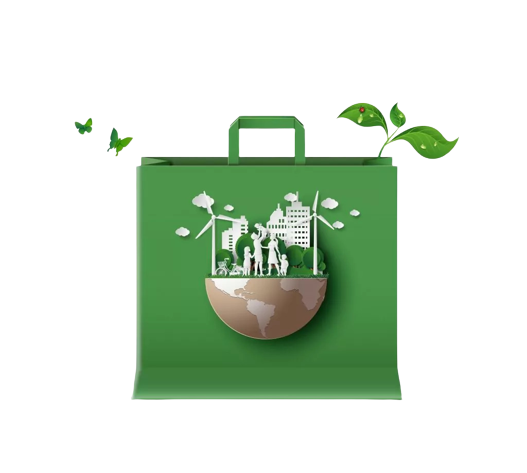Introduction
Most people in the kitchen use cling wrap to store food, but did you know that not all cling wrap is equal? Nowadays, many individuals are making the change from plastic cling wrap to eco-friendly biodegradable cling wrap. Why, you ask? It’s much nicer for the planet.
Here at the blog, we’ll explain the distinction between biodegradable cling wrap and plastic cling wrap, and assist you in determining which one’s right for you. And, we’ll demonstrate how to dispose of each correctly as well as address a few frequently asked questions.
What Is Biodegradable Cling Wrap?
]Biodegradable plastic wrap is produced from natural materials such as corn starch, PLA (a form of plant-based plastic), or PBAT. Rather than resting in a landfill for centuries, this type of wrap decomposes in compost, typically in 90 to 180 days. It’s also called compostable cling wrap because it can be composted if you just toss it in the proper location, like a compost pile or industrial compost facility.
What’s so special about it?
- It’s plant-based
- It’s BPA-free and non-toxic
- It’s perfect for short-term food storage
- It’s not as stretchy as plastic but gets the job done
Also, if you’re using biodegradable compostable cling wrap, ensure that it is certified with something such as ASTM D6400 or EN 13432. That’s because it’s actually compostable and not harmful to the environment.
If you’re looking to completely get eco-friendly, you should also look at other awesome products such as compostable grocery bags or biodegradable bubble wrap for your kitchen and storage needs.
What Is Plastic Cling Wrap?
Plastic cling wrap is what most of us have been using for years. It’s made from materials like PVC (polyvinyl chloride) or LDPE (low-density polyethylene), both of which are made from fossil fuels. It’s cheap, super stretchy, and seals food really well—but there’s a catch. It’s not biodegradable, not compostable, and most of the time, not recyclable either.
Why it’s a problem:
- It can stay in landfills for hundreds of years
- It occasionally drips toxic chemicals, particularly when it’s microwaved
- It’s a huge component of the world’s plastic pollution issue
Though plastic wrap may be more convenient to locate and inexpensive to purchase, daily use contributes greatly to overall waste. That’s why increasingly individuals are turning away from plastic wrap and switching to environmentally friendly alternatives such as compostable trash bags and biodegradable stretch film for packaging and storing.
Comparison: Biodegradable Cling Wrap vs. Plastic Cling Wrap
| Attribute | Biodegradable Cling Wrap | Plastic Cling Wrap |
| Material | Made from renewable, plant-based sources (PLA, PBAT, starch) | Made from petroleum-based plastics (PVC, LDPE) |
| Decomposition Time | Breaks down in 90–180 days under composting conditions | Can take 100+ years to degrade in landfills |
| Environmental Impact | Low impact, compostable, reduces plastic pollution | High impact, contributes to landfill and marine waste |
| Health Risk | BPA-free, non-toxic, safe for most food uses | May leach toxic chemicals, especially when heated |
| Cost | Slightly more expensive due to sustainable materials | Generally cheaper and mass-produced |
| Performance | Moderate stretch and seal, suitable for light usage | Strong stretch, better cling for long-term storage |
| Microwave Safe | Usually safe (check label for confirmation) | PVC-based wraps may not be safe for microwave use |
| Disposal | Compost bin or green waste (if certified compostable) | Trash bin (rarely recyclable through curbside programs) |
How to Properly Dispose of Cling Wrap?
It’s really crucial that you dispose of cling wrap properly, particularly if you’re attempting to eliminate waste.
Biodegradable Cling Wrap:
- If it is labeled home-compostable, throw it in your backyard compost pile.
- If it is not home-compostable, take it to an industrial composting facility (check to see if this resource is available near you).
- Do not place it in the recycling bin. It does not belong there.
Plastic Cling Wrap:
- Most curbside recycling programs do not accept it
- Some grocery stores offer plastic film drop-off locations
- If not, your only option is to place it in the trash
Bonus tip: If you’re in the process of greening your kitchen, you might also begin using compostable grocery and food storage carry bags. Every little bit helps!
Conclusion
Biodegradable cling wrap (or eco-friendly cling wrap) is a wonderful choice if you’re concerned about the planet and want to minimize waste. Sure, it may be a bit more expensive and less stretchy, but it’s healthier for your health and much better for the planet.
Meanwhile, plastic cling wrap is inexpensive and effective, but it lingers on for centuries and isn’t helping our planet at all. Small changes, such as making the switch to compostable kitchen items or a compostable garment bag while shopping, can add up to make an enormous impact in the long run.
FAQs
Q1. Is biodegradable cling wrap actually compostable?
Yes! Depending on the kind. Some are compostable at home, and others must be taken to a commercial composting center. Always look for certification on the package.
Q2. Can I microwave food using biodegradable cling wrap?
Generally, yes. Most brands are microwave-safe, but do check the package just in case. And don’t put it directly on the super-hot or greasy food unless they say it’s safe.
Q3. Can plastic cling wrap be recycled?
Not exactly. Plastic wraps become contaminated with food and cannot be taken at the curbside. It typically goes into the landfill and remains there for decades.
Q4. Why is biodegradable cling wrap so pricey?
It’s produced from renewable, natural sources, and the production is scaled down. And obtaining certification as compostable (such as with ASTM D6400) is an added expense. But it’s well worth it for the planet.



